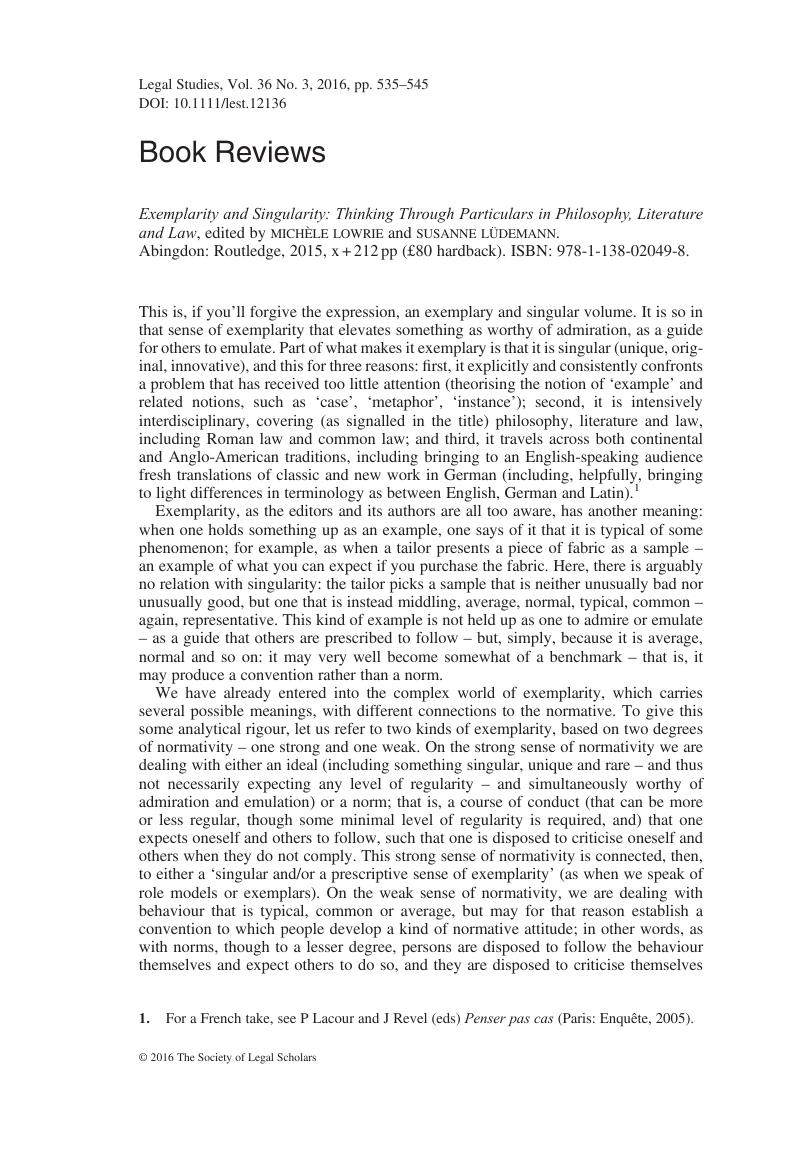No CrossRef data available.
Article contents
Exemplarity and Singularity: Thinking through Particulars in Philosophy, Literature and Law, edited by Michèle Lowrie and Susanne Lüdemann. Abingdon: Routledge, 2015, x + 212 pp (£80 hardback). ISBN: 978-1-138-02049-8.
Published online by Cambridge University Press: 02 January 2018
Abstract

- Type
- Book Review
- Information
- Copyright
- Copyright © Society of Legal Scholars 2016
References
1. For a French take, see Lacour, P and Revel, J (eds) Penser pas cas (Paris: Enquête, 2005)Google Scholar.
2. For some philosophers of normativity, conventions are not normative at all, but this seems rash to me: persons can develop normative commitments to conventions, even if they are often not as strongly held as commitments to norms (the other difference is that conventions often develop to solve coordination problems and are typically in the self-interest of persons, whereas norms are often constraints on self-interest).
3. Lowrie, and Lüdemann, ‘Introduction’ in Lowrie, M and Lüdemann, S (eds) Exemplarity and Singularity: Thinking Through Particulars in Philosophy, Literature and Law (Abingdon: Routledge, 2015) p 2 Google Scholar.
4. Ibid, p 5. The full quote is worth including: ‘The grey area between generals and particulars where imagination and judgement proceed by comparing and contrasting, grouping and regrouping “cases”, separating out what does not fit some overarching system, calls for further examination.’
5. A wonderful example is Wood, M Literature and the Taste of Knowledge (Cambridge: Cambridge University Press, 2005)CrossRefGoogle Scholar.
6. See Samuel, G Epistemology and Method in Law (Aldershot: Ashgate, 2003)Google Scholar.
7. See Jackson, B Law, Fact and Narrative Coherence (Liverpool: Deborah Charles, 1988).Google Scholar
8. See, in particular, two collections: Bankowski, Z and McLean, J (eds) The Universal and the Particular in Legal Reasoning (Aldershot: Ashgate, 2006)Google Scholar; Del Mar, M and Michelon, C (eds) The Anxiety of the Jurist (Aldershot: Ashgate, 2013).Google Scholar
9. Levi, E An Introduction to Legal Reasoning (Chicago: University of Chicago Press, 1949).Google Scholar
10. H Lipps ‘Instance, example, case, and the relationship of the legal case to the law’ in Lowrie and Lüdemann, above n 3, pp 28–29; original emphasis.
11. Ibid, p 29; original emphasis.
12. Idem; original emphasis.
13. M Möller ‘Exemplum and exceptio: building blocks for a rhetorical theory of the exceptional case’, in Lowrie and Lüdemann, above n 3, p 99.
14. Ibid, p 102.
15. Ibid, p 103.
16. See, eg, Hurley, SL ‘Coherence, hypothetical cases, and precedent’ (1990) 10(2) Oxford J Legal Stud 221 CrossRefGoogle Scholar. There are some fascinating connections here to the use of concrete, imaginary hypotheticals in the process of moral reasoning – a process recognised to have been important by Kant, Hare and Dewey.
17. C Ando ‘Exemplum, analogy and precedent in Roman law’, in Lowrie and Lüdemann, above n 3.
18. Ibid, p 113.
19. Ibid, p 114; and see Ando, C Roman Social Imaginaries (Toronto: Toronto University Press, 2015)Google Scholar.
20. Ando, above n 17, p 118.
21. On this process in more detail, see Stone, J Precedent and Law: Dynamics of Common Law Growth (Sydney: Butterworths, 1985).Google Scholar
22. P Goodrich ‘The exampleless example: of the infinite particulars of early modern common law’, in Lowrie and Lüdemann, above n 3.
23. Ibid, p 141. For more on the connection between image, memory and moral instruction, see Carruthers, M The Craft of Thought: Meditation, Rhetoric and the Making of Images, 400–1200 (Cambridge: Cambridge University Press, 1998)Google Scholar. And for more on emblematic exampla, see Goodrich, P Legal Emblems and the Art of Law: Obiter depicta as the Vision of Governance (Cambridge: Cambridge University Press, 2014)Google Scholar.
24. Goodrich, above n 22, pp 142–143.
25. Ibid, p 147.
26. Ibid, p 144.


